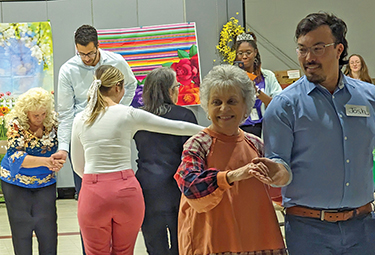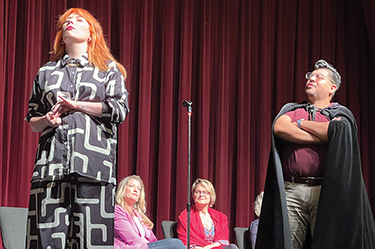Public health enthusiasts showed their love for APHA’s National Public Health Week in April by celebrating the way communities, professionals and individuals intertwine to strengthen health.
From coast to coast and beyond, advocates organized activities centered on the NPHW theme of “Protecting, Connecting and Thriving: We Are All Public Health.”
Health fairs, campus events, theater shows, art projects, webinars, panel discussions and more were held in hundreds of communities April 1-7.
“This year’s NPHW theme served as an entry point to public health,” Lindsey Wahowiak, APHA director of Affiliate Affairs, told The Nation’s Health. “People sometimes don’t realize the opportunities they have to make a difference in the health of their communities. At so many events with APHA and across the country, people could see themselves in public health, maybe for the first time.”
Scot McIntosh, MS, assistant dean for student affairs at West Virginia University, hosted a webinar on AI in public health on April 7, which highlighted new tools and innovations.
Along with events, NPHW is about community, networking, sharing ideas and, for the West Virginia university, creating a buzz about its School of Public Health, McIntosh said.
“National Public Health Week allows us to elevate those types of experiences and conversations,” he told The Nation’s Health. “It's one of my favorite weeks of the year.”
In Texas, organizers created a winning combination by bringing together the arts and health sciences.
The University of Texas School of Public Health at San Antonio partnered with the San Pedro Playhouse to organize three performances in dance, music and theatre acting. A discussion followed led by scientists on the benefits of each type of performance on brain and physical health.
“There is plenty of research that states that theatre and performance positively benefits our social, emotional and physical well-being,” said Fidel Flores, MBA, marketing and communications manager at the School of Public Health. “San Antonio has a vibrant arts community, and we took this opportunity to combine physicians, researchers and academics with artists on a panel to legitimize arts’ impact on health.”
The intersection of art and health will continue, he said.
“We have established partnerships with arts organizations and are eager to explore ways to incorporate their values and contributions into our educational framework,” Flores told The Nation’s Health.
In Ohio, a ballroom dance for older people was so fun and successful, a dance redux is already being planned.
The Northeast Ohio Medical University and the Consortium of Eastern Ohio Master of Public Health turned a hall into a ballroom dance floor for the event. Twelve medical students danced the day away with older people visiting from local senior centers. For the guests who did not dance, the students interacted with them and heard amazing stories.
Part of the event’s inspiration came from a report from the Centers for Disease Control and Prevention that nearly 1 in 4 older adults are socially isolated, said Amy Lee, MD, MPH, MBA, program director of the Consortium of Eastern Ohio Master of Public Health.
“The guests that came said that they were looking forward to coming to another dance and that they would bring their friends,” Lee told The Nation’s Health. “Students of geriatrics, palliative care and ballroom clubs also wanted to collaborate and have another event in the fall.”
“Students of geriatrics, palliative care and ballroom clubs also wanted to collaborate and have another event in the fall.”
APHA’s member groups and state and local public health associations were also active during NPHW. The Ohio Public Health Association held a virtual book club. Attendees discussed Mona Hanna-Attisha’s “What the Eyes Don’t See: A Story of Crisis, Resistance and Hope in an American City,” which focused on the Flint, Michigan, water crisis. Hanna-Attisha, MD, MPH, FAAP, exposed the crisis by sharing science linking exposure to elevated lead levels in children.
During APHA’s NPHW Chat on X and Threads — which received more than 59 million impressions — the Ohio association underscored its commitment to strengthening health workers’ skills to better meet state challenges.
“We care about public health,” the Affiliate said on X during the chat. “We care about Ohio. And we would love to have you join us as an advocate
APHA’s Foot and Ankle Health Section was active with three webinars, a trivia night and support for H.R. 1634, legislation in Congress that would add podiatrists to the list of physicians eligible for Medicaid reimbursement. The bill is expected to help reduce leg amputations through preventive care for disadvantaged groups.

Besides the chat, APHA held 10 other events during NPHW. Among these were a discussion between APHA President Ella Greene-Moton and Derrick Johnson, JD, president and CEO of NAACP. They talked about the collaboration between public health and NAACP on issues involving race.
During APHA’s NPHW kickoff forum, eco-drag queen Pattie Gonia talked about the importance of public health, climate activists, community members. Instead of seeing people as pieces of a machine, Gonia compared them to “a healthy meadow.” They thanked public health services and professionals for empowering a “queer youth coming from Nebraska.”
“You are people doing work with people who are in the margins and doing critical work in the environmental movement and the social justice movement,” Gonia said.
Other APHA activities included career-building events on Student Day and discussions on the All of Us Research Program, climate health and Public Health AmeriCorps. Another webinar, a recording of which can be viewed online, highlighting the public health challenges of people with intellectual and developmental disabilities.
APHA’s Keep It Moving Challenge concluded April 7, the last day of NPHW, and was a resounding success. Over 2,400 individuals logged 1 billion steps, up by 100 million from last year. For the second year in a row, Cope Kansas collected the most steps, at 2.3 million steps. Savage Beasts and Nurses Dance Party, both with 1.9 million steps, came in next.
In 2025, National Public Health Week will be held April 7-13. For more information, visit www.nphw.org.
Photo caption: Above: The Northeast Ohio Medical University and the Consortium of Eastern Ohio Master of Public Health turned a hall into a ballroom dance floor. (Photo courtesy University of Texas School of Public Health-San Antonio) Below: The University of Texas School of Public Health at San Antonio partnered with the San Pedro Playhouse to organize three performances in dance, music and theatre acting. (Photo courtesy the University of Texas School of Public Health at San Antonio)